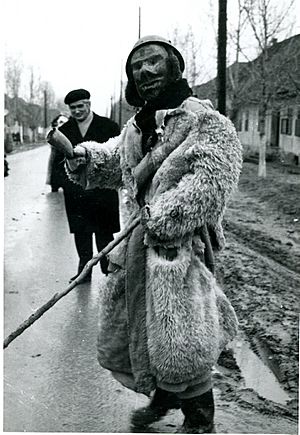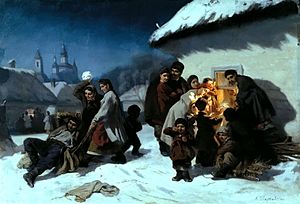Koledari facts for kids
Koledari are traditional performers from Slavic countries. They take part in a special ceremony called koleduvane, which is like Christmas caroling. This tradition is linked to Koliada, an ancient celebration that later became part of Christmas.
This type of caroling has different names. In Bulgaria, it's called "коледуване" (koleduvane). In Romania, it's "colindat". In Ukraine, it's "колядування" (kolyaduvannya). And in North Macedonia, it's "коледарење" (koledarenje) or "коледе" (kolede).
Contents
Koledari in Bulgaria
In Bulgaria, the koledari carolers begin their singing right at midnight on Christmas Eve. They visit the homes of their family, friends, and other people in the village. Young men usually do the caroling. An older man, called a stanenik, goes with them.
Each caroler carries a stick called a gega. They wish everyone in the village good health, wealth, and happiness. The time for koleduvane is very specific. It starts at midnight on Christmas Eve and ends at dawn. People believe their songs help chase away bad spirits. After sunrise, this special power is gone, so they stop caroling.
Preparations for this tradition start on December 20. The men wear special festive clothes. They also have unique decorations on their hats.
Koledari in North Macedonia
In North Macedonia, the caroling starts early in the morning on January 6. This day is Christmas Eve, also known as Badnik in Macedonian. Usually, children are the ones who go caroling. They go from house to house, waking people up with a song.
They sing songs called koledarski pesni, which are a type of carol. After the children finish their song, the people they sang for give them gifts. These gifts can be money, fruit, candies, or chocolate. The children usually start caroling between 5 AM and 11 AM. They visit homes all over their neighborhood or village.
Koledari in Serbia

In Serbia, Koledari get ready for several days before the koleda begins. They practice their special koleda songs. They also make their unique masks and costumes.
Special Costumes and Masks
The masks can be grouped into three types. Some look like people, some look like animals (like bears, cows, or goats), and some are a mix of both. These masks are mostly made from animal hides. The face part might be made from a dried gourd or wood. It is then sewn onto the hide so the mask covers the whole head.
For the mustache, beard, and eyebrows, they use black wool, horsehair, or hemp fibers. Beans are sometimes used for teeth. Animal-like masks might have white, black, or red horns attached. The costumes are made from old clothes, sheepskins (with the wool facing out), or calf hides. Sometimes, an ox tail with a bell is attached to the back of the costume.
The Koledari Group
The leader of the group is called "Grandpa." The other koledari meet at his house on the evening before koleda. At midnight, they all go out and start their activities. As they walk through the village streets, they shout and make noise. They use their bells and ratchets. Most of them carry sabers or clubs.
One person in the group is called "Bride." This person wears a mask and costume like a pregnant woman. They hold a distaff and pretend to spin hemp fibers. The koledari joke and tease "Bride," which adds a funny part to the koleda. Some members are called alosniks. These are men believed to be controlled by the demon ala. Other special characters might also be part of the group.
Songs and Traditions
The koledari sing special songs. The word koledo is added in the middle and at the end of each line of their songs.
Besides singing, the koledari also try to chase away bad spirits from homes. First, they search the house to find where these spirits might be hiding. They look everywhere, shouting, dancing, and jumping. They also knock on the floor and walls with their sticks. When they find the spirits, they drive them out. They fight them by swinging their sabers and clubs.
After the spirits are gone, the koledari do a short dance called the kolo. Then, they bless the household. As a thank you, they receive a special loaf of bread that the family made for them. They also get other food gifts.
Koledari in Ukraine
One of the most famous Ukrainian kolyadka songs is Shchedryk. It was arranged by Mykola Leontovych in 1916. This song was later made into an English Christmas carol called Carol of the Bells by Peter J. Wilhousky.
See also




